SKODA OCTAVIA TOUR 2009 1.G / (1U) Owner's Manual
Manufacturer: SKODA, Model Year: 2009, Model line: OCTAVIA TOUR, Model: SKODA OCTAVIA TOUR 2009 1.G / (1U)Pages: 226, PDF Size: 13.11 MB
Page 111 of 226
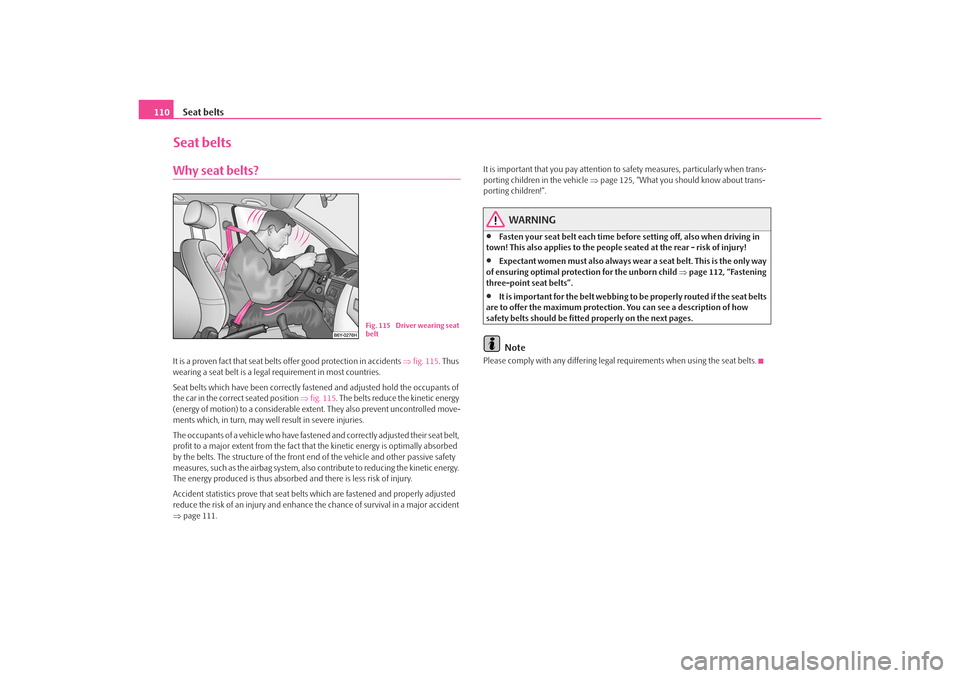
Seat belts
110Seat beltsWhy seat belts?It is a proven fact that seat belt s offer good protection in accidents ⇒fig. 115 . Thus
wearing a seat belt is a legal requirement in most countries.
Seat belts which have been correctly fastened and adjusted hold the occupants of
the car in the correc t seated position ⇒fig. 115 . The belts reduce the kinetic energy
(energy of motion) to a considerable extent. They also prevent uncontrolled move-
ments which, in turn, may well result in severe injuries.
The occupants of a vehicle who have fastened and correctly adjusted their seat belt,
profit to a major extent from the fact that the kinetic energy is optimally absorbed
by the belts. The structure of the front end of the vehicle and other passive safety
measures, such as the airbag system, also contribute to reducing the kinetic energy.
The energy produced is thus absorbed and there is less risk of injury.
Accident statistics prove that seat belts which are fastened and properly adjusted
reduce the risk of an injury and enhance the chance of survival in a major accident
⇒ page 111. It is important that you pay attention to
safety measures, particularly when trans-
porting children in the vehicle ⇒page 125, “What you should know about trans-
porting children!”.
WARNING
•
Fasten your seat belt each time before setting off, also when driving in
town! This also applies to the people seated at the rear - risk of injury!
•
Expectant women must also always wear a seat belt. This is the only way
of ensuring optimal protection for the unborn child ⇒ page 112, “Fastening
three-point seat belts”.
•
It is important for the belt webbing to be properly routed if the seat belts
are to offer the maximum protection. You can see a description of how
safety belts should be fitted properly on the next pages.Note
Please comply with any differing legal requirements when using the seat belts.
Fig. 115 Driver wearing seat
belt
s2ig.book Page 110 Monday, November 10, 2008 11:20 AM
Page 112 of 226
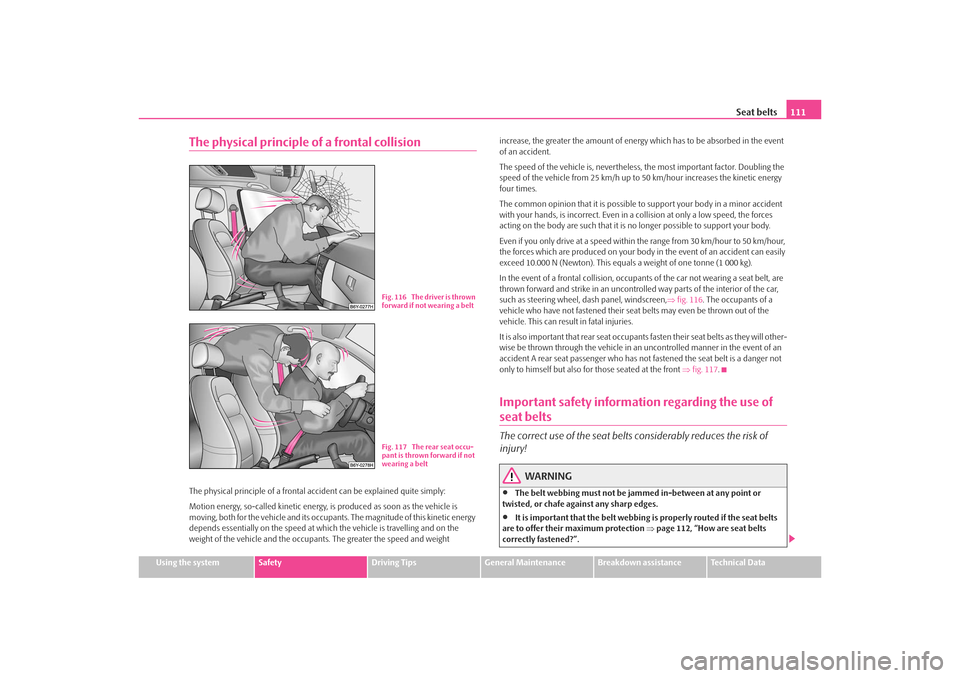
Seat belts111
Using the system
Safety
Driving Tips
General Maintenance
Breakdown assistance
Technical Data
The physical principle of a frontal collisionThe physical principle of a frontal a ccident can be explained quite simply:
Motion energy, so-called kinetic energy, is produced as soon as the vehicle is
moving, both for the vehicle and its occupants. The magnitude of this kinetic energy
depends essentially on the speed at which the vehicle is travelling and on the
weight of the vehicle and the occupant s. The greater the speed and weight increase, the greater the amount of energy which has to be absorbed in the event
of an accident.
The speed of the vehicle is, nevertheless,
the most important factor. Doubling the
speed of the vehicle from 25 km/h up to 50 km/hour increases the kinetic energy
four times.
The common opinion that it is possible to support your body in a minor accident
with your hands, is incorrect. Even in a collision at only a low speed, the forces
acting on the body are such that it is no longer possible to support your body.
Even if you only drive at a speed within the range from 30 km/hour to 50 km/hour,
the forces which are produced on your body in the event of an accident can easily
exceed 10.000 N (Newton). This equals a weight of one tonne (1 000 kg).
In the event of a frontal collision, occupants of the car not wearing a seat belt, are
thrown forward and strike in an uncontrolled way parts of the interior of the car,
such as steering wheel, dash panel, windscreen, ⇒fig. 116 . The occupants of a
vehicle who have not fastened their seat belts may even be thrown out of the
vehicle. This can resu lt in fatal injuries.
It is also important that rear seat occupants fasten their seat belts as they will other-
wise be thrown through the vehicle in an uncontrolled manner in the event of an
accident A rear seat passenger who has not fastened the seat belt is a danger not
only to himself but also fo r those seated at the front ⇒fig. 117 .
Important safety information regarding the use of seat beltsThe correct use of the seat belts considerably reduces the risk of
injury!
WARNING
•
The belt webbing must not be jammed in-between at any point or
twisted, or chafe ag ainst any sharp edges.
•
It is important that the belt webbing is properly routed if the seat belts
are to offer their maximum protection ⇒page 112, “How are seat belts
correctly fa stened?”.
Fig. 116 The driver is thrown
forward if not wearing a beltFig. 117 The rear seat occu-
pant is thrown forward if not
wearing a belt
s2ig.book Page 111 Monday, November 10, 2008 11:20 AM
Page 113 of 226
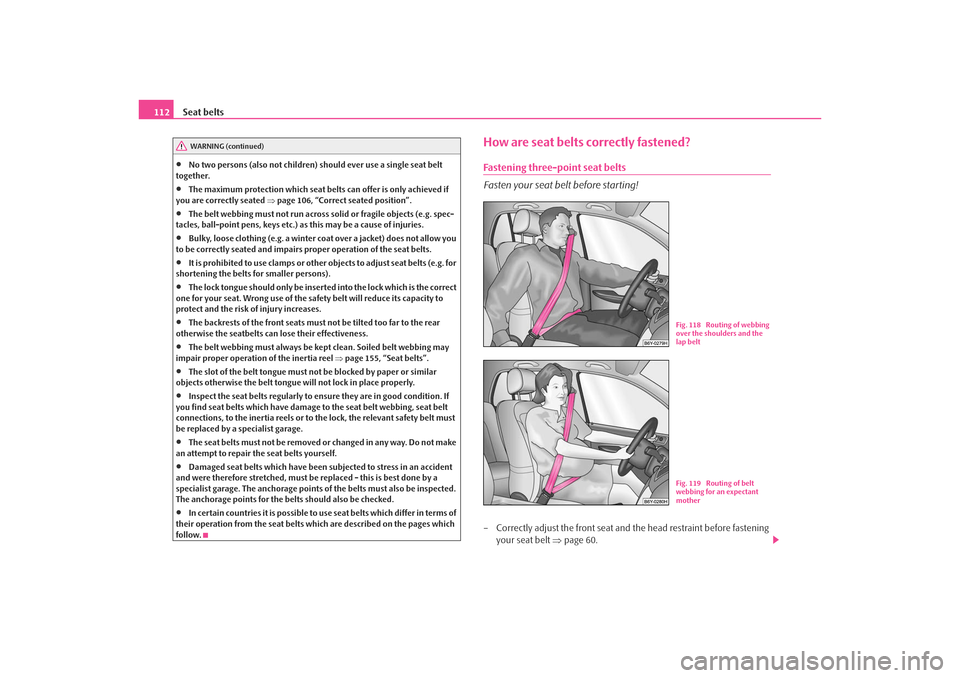
Seat belts
112•
No two persons (also not children) should ever use a single seat belt
together.
•
The maximum protection which seat belts can offer is only achieved if
you are correctly seated ⇒page 106, “Correct seated position”.
•
The belt webbing must no t run across solid or fragile objects (e.g. spec-
tacles, ball-point pens, keys etc.) as this may be a cause of injuries.
•
Bulky, loose clothing (e.g. a winter coat over a jacket) does not allow you
to be correctly seated and impairs proper operation of the seat belts.
•
It is prohibited to use clamps or other objects to adjust seat belts (e.g. for
shortening the belts for smaller persons).
•
The lock tongue should only be insert ed into the lock which is the correct
one for your seat. Wrong use of the safety belt will reduce its capacity to
protect and the risk of injury increases.
•
The backrests of the front seats must not be tilted too far to the rear
otherwise the seatbelts can lose their effectiveness.
•
The belt webbing must always be ke pt clean. Soiled belt webbing may
impair proper operation of the inertia reel ⇒page 155, “Seat belts”.
•
The slot of the belt tongue must not be blocked by paper or similar
objects otherwise the belt tongue will not lock in place properly.
•
Inspect the seat belts regularly to ensure they are in good condition. If
you find seat belts which have damage to the seat belt webbing, seat belt
connections, to the inertia reels or to the lock, the relevant safety belt must
be replaced by a specialist garage.
•
The seat belts must not be removed or changed in any way. Do not make
an attempt to repair the seat belts yourself.
•
Damaged seat belts which have been subjected to stress in an accident
and were therefore stretched, must be replaced - this is best done by a
specialist garage. The anchorage points of the belts must also be inspected.
The anchorage points for the be lts should also be checked.
•
In certain countries it is possible to use seat belts which differ in terms of
their operation from the seat belts which are described on the pages which
follow.
How are seat belts correctly fastened?Fastening three-point seat belts
Fasten your seat belt before starting!– Correctly adjust the front seat and the head restraint before fastening
your seat belt ⇒page 60.
WARNING (continued)
Fig. 118 Routing of webbing
over the shoulders and the
lap beltFig. 119 Routing of belt
webbing for an expectant
mother
s2ig.book Page 112 Monday, November 10, 2008 11:20 AM
Page 114 of 226
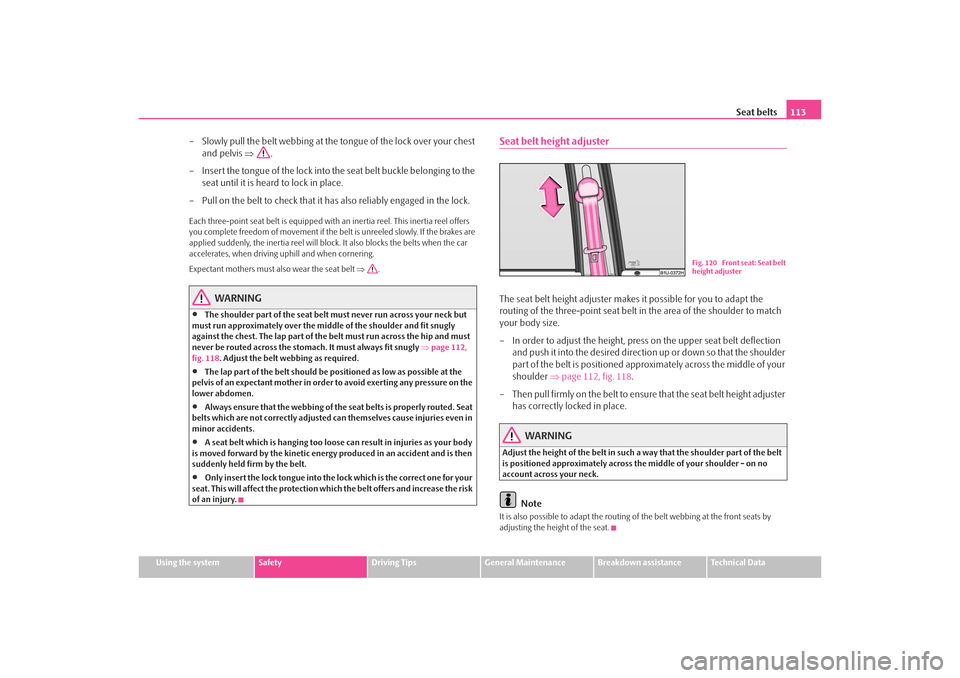
Seat belts113
Using the system
Safety
Driving Tips
General Maintenance
Breakdown assistance
Technical Data
– Slowly pull the belt webbing at the to ngue of the lock over your chest
and pelvis ⇒.
– Insert the tongue of the lock into th e seat belt buckle belonging to the
seat until it is heard to lock in place.
– Pull on the belt to check that it has also reliably engaged in the lock.Each three-point seat belt is equipped with an inertia reel. This inertia reel offers
you complete freedom of movement if the belt is unreeled slowly. If the brakes are
applied suddenly, the inertia reel will block. It also blocks the belts when the car
accelerates, when driving uphill and when cornering.
Expectant mothers must also wear the seat belt ⇒.
WARNING
•
The shoulder part of the seat belt must never run across your neck but
must run approximately over the middl e of the shoulder and fit snugly
against the chest. The lap part of the belt must run across the hip and must
never be routed across the stomach. It must always fit snugly ⇒page 112,
fig. 118 . Adjust the belt webbing as required.
•
The lap part of the belt should be positioned as low as possible at the
pelvis of an expectant mother in order to avoid exerting any pressure on the
lower abdomen.
•
Always ensure that the webbing of the seat belts is properly routed. Seat
belts which are not correctly adjusted ca n themselves cause injuries even in
minor accidents.
•
A seat belt which is hanging too loose can result in injuries as your body
is moved forward by the kinetic energy produced in an accident and is then
suddenly held firm by the belt.
•
Only insert the lock tongue into the lo ck which is the correct one for your
seat. This will affect the protection whic h the belt offers and increase the risk
of an injury.
Seat belt height adjusterThe seat belt height adjuster makes it possible for you to adapt the
routing of the three-point seat belt in the area of the shoulder to match
your body size.
– In order to adjust the height, press on the upper seat belt deflection
and push it into the desired direction up or down so that the shoulder
part of the belt is positioned appr oximately across the middle of your
shoulder ⇒page 112, fig. 118 .
– Then pull firmly on the belt to ensure that the seat belt height adjuster
has correctly locked in place.
WARNING
Adjust the height of the belt in such a way that the shoulder part of the belt
is positioned approximately across the middle of your shoulder - on no
account across your neck.
Note
It is also possible to adapt the routing of the belt webbing at the front seats by
adjusting the height of the seat.
Fig. 120 Front seat: Seat belt
height adjuster
s2ig.book Page 113 Monday, November 10, 2008 11:20 AM
Page 115 of 226
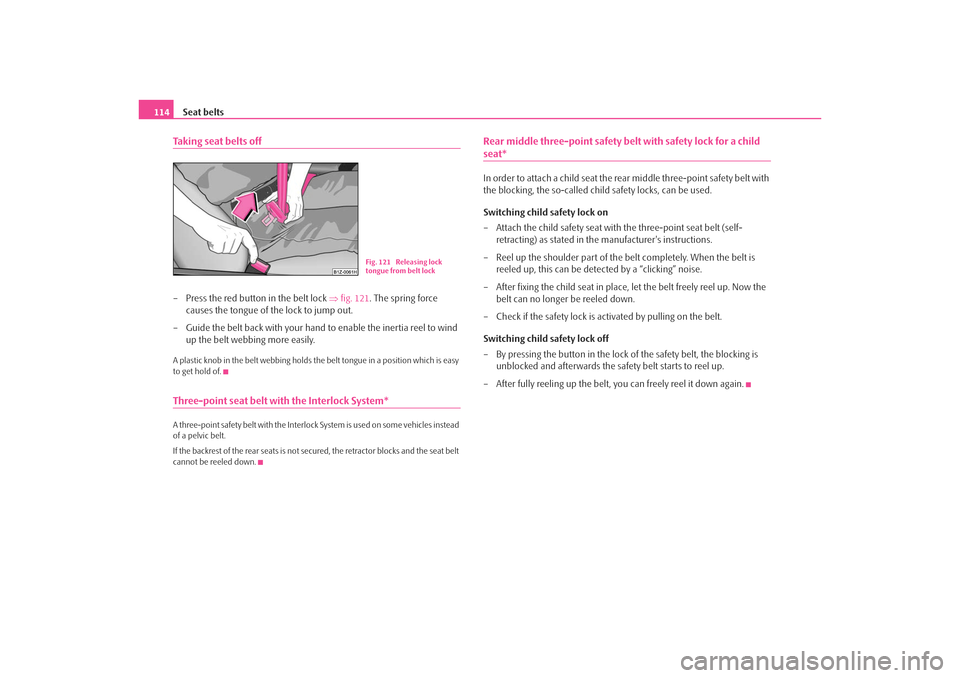
Seat belts
114Taking seat belts off– Press the red button in the belt lock ⇒fig. 121 . The spring force
causes the tongue of the lock to jump out.
– Guide the belt back with your hand to enable the inertia reel to wind
up the belt webbing more easily.A plastic knob in the belt webbing holds the belt tongue in a position which is easy
to get hold of.Three-point seat belt with the Interlock System*A three-point safety belt with the Interlock System is used on some vehicles instead
of a pelvic belt.
If the backrest of the rear seats is not secured, the retractor blocks and the seat belt
cannot be reeled down.
Rear middle three-point safety belt with safety lock for a child seat*In order to attach a child seat the rear middle three-point safety belt with
the blocking, the so-called chil d safety locks, can be used.
Switching child safety lock on
– Attach the child safety seat with the three-point seat belt (self- retracting) as stated in the manufacturer's instructions.
– Reel up the shoulder part of the belt completely. When the belt is
reeled up, this can be detected by a “clicking” noise.
– After fixing the child seat in place, let the belt freely reel up. Now the belt can no longer be reeled down.
– Check if the safety lock is activated by pulling on the belt.
Switching child safety lock off
– By pressing the button in the lock of the safety belt, the blocking is
unblocked and afterwards the safety belt starts to reel up.
– After fully reeling up the belt, you can freely reel it down again.
Fig. 121 Releasing lock
tongue from belt lock
s2ig.book Page 114 Monday, November 10, 2008 11:20 AM
Page 116 of 226

Seat belts115
Using the system
Safety
Driving Tips
General Maintenance
Breakdown assistance
Technical Data
The pelvic belt*The rear middle seat is fitted with a pelvic belt. The lock part of the two-
point pelvic belt is operated in the same way as for a three-point safety
belt. An unused pelvic belt should be stowed away together with the lock
for safety reasons.
Extending the pelvic belt
– Hold the lock tongue at right an gles to the belt webbing and pull
through the desired amount of belt webbing ⇒fig. 123 . Shortening the pelvic belt
– Pull on the free end of the belt.
– Fix the excess belt length by threading it through the plastic slider.
The adjustment of the belt length is facili
tated by simultaniously pressing the belt
tongue and the belt cover lengthwise.
WARNING
The pelvic belt must always sit firmly across the pelvis; tighten the belt
webbing if necessary.Belt tensionersSafety for the driver and front passenger wearing their seat belts is enhanced by
the belt tensioners fitted to the inertia reels of the front three-point seat belts, in
addition to the protection afforded by the airbag system.
The three-point seat belts are automatically tensioned in the event of a frontal colli-
sion of a certain severity. The belt tensioners can also be deployed if the seat belts
are not fastened.
The belt tensioner is deployed in the event of a frontal collision of major severity. A
powder charge is ignited in the inertia reels during deployment. The belt webbing
is pulled into the inertia reels by a mech anical system and the belt is tensioned.
Belt tensioners are not activated in the ev ent of minor frontal collisions, side and
rear-end collisions, in the case of a rollover and also not in accidents in which no
major forces are produced from the front.
WARNING
•
Any work on the system including removal and installation of system
components because of other repair work, must only be carried out by a
specialist garage.
Fig. 122 Fasten pelvic beltFig. 123 Extending the pelvic
belt
s2ig.book Page 115 Monday, November 10, 2008 11:20 AM
Page 117 of 226
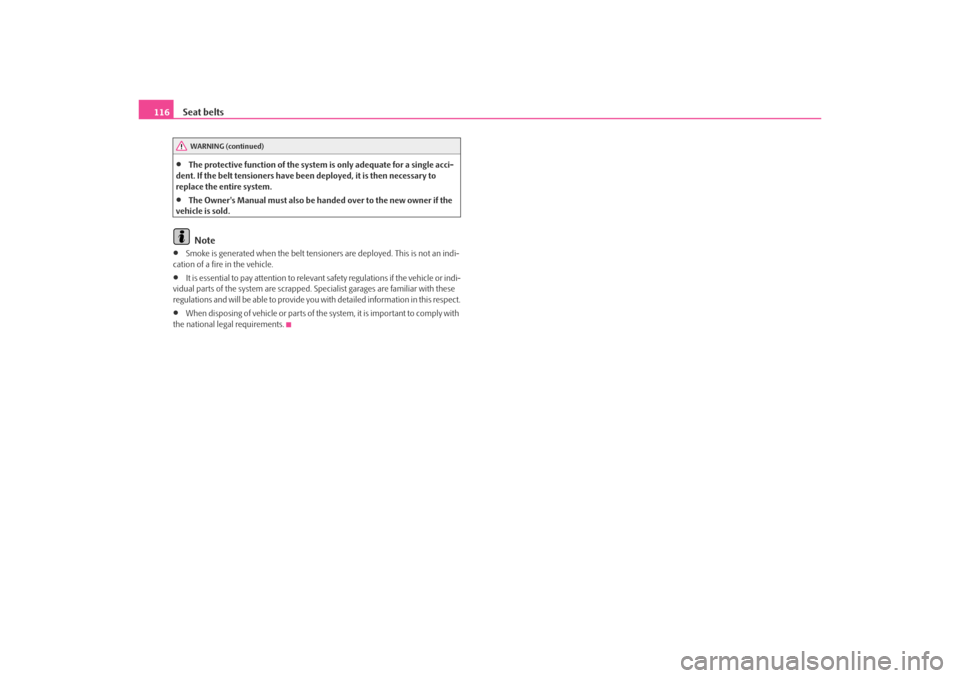
Seat belts
116•
The protective function of the system is only adequate for a single acci-
dent. If the belt tensioners have been deployed, it is then necessary to
replace the entire system.
•
The Owner's Manual must also be handed over to the new owner if the
vehicle is sold.Note
•
Smoke is generated when the belt tensione rs are deployed. This is not an indi-
cation of a fire in the vehicle.
•
It is essential to pay attention to relevant safety regulations if the vehicle or indi-
vidual parts of the system are scrapped. Sp ecialist garages are familiar with these
regulations and will be able to provide you with detailed information in this respect.
•
When disposing of vehicle or parts of the system, it is important to comply with
the national legal requirements.WARNING (continued)
s2ig.book Page 116 Monday, November 10, 2008 11:20 AM
Page 118 of 226
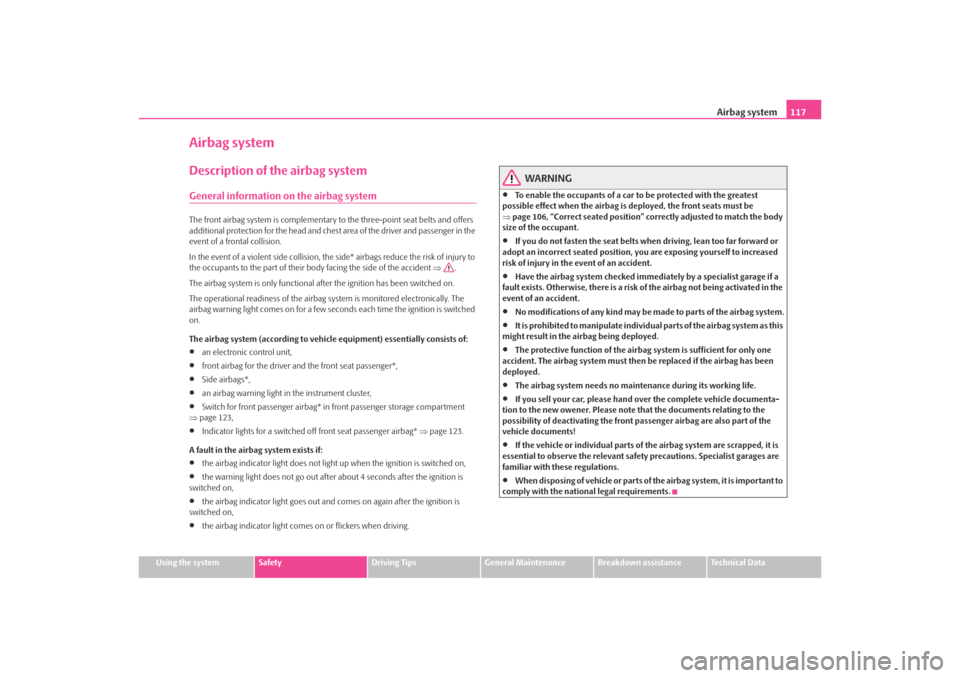
Airbag system117
Using the system
Safety
Driving Tips
General Maintenance
Breakdown assistance
Technical Data
Airbag systemDescription of the airbag systemGeneral information on the airbag systemThe front airbag system is complementary to the three-point seat belts and offers
additional protection for the head and chest area of the driver and passenger in the
event of a frontal collision.
In the event of a violent side collision, the side* airbags reduce the risk of injury to
the occupants to the part of their bo dy facing the side of the accident ⇒.
The airbag system is only functional af ter the ignition has been switched on.
The operational readiness of the airbag system is monitored electronically. The
airbag warning light comes on for a few seconds each time the ignition is switched
on.
The airbag system (according to vehicl e equipment) essentially consists of:•
an electronic control unit,
•
front airbag for the driver and the front seat passenger*,
•
Side airbags*,
•
an airbag warning light in the instrument cluster,
•
Switch for front passenger airbag* in front passenger storage compartment
⇒ page 123,
•
Indicator lights for a switched off front seat passenger airbag* ⇒page 123.
A fault in the airbag system exists if:
•
the airbag indicator light do es not light up when the ignition is switched on,
•
the warning light does not go out after about 4 seconds after the ignition is
switched on,
•
the airbag indicator light goes out and comes on again after the ignition is
switched on,
•
the airbag indicator light comes on or flickers when driving.
WARNING
•
To enable the occupants of a car to be protected with the greatest
possible effect when the airbag is deployed, the front seats must be
⇒ page 106, “Correct seated position” co rrectly adjusted to match the body
size of the occupant.
•
If you do not fasten the seat belts when driving, lean too far forward or
adopt an incorrect seated position, yo u are exposing yourself to increased
risk of injury in the event of an accident.
•
Have the airbag system checked immedi ately by a specialist garage if a
fault exists. Otherwise, there is a risk of the airbag not being activated in the
event of an accident.
•
No modifications of any kind may be made to parts of the airbag system.
•
It is prohibited to manipulate individual parts of the airbag system as this
might result in the airbag being deployed.
•
The protective function of the airbag system is sufficient for only one
accident. The airbag system must then be replaced if the airbag has been
deployed.
•
The airbag system needs no main tenance during its working life.
•
If you sell your car, please hand over the complete vehicle documenta-
tion to the new owener. Please note that the documents relating to the
possibility of deactivating the front passenger airbag are also part of the
vehicle documents!
•
If the vehicle or individual parts of the airbag system are scrapped, it is
essential to observe the relevant safety precautions. Specialist garages are
familiar with these regulations.
•
When disposing of vehicle or parts of the airbag system, it is important to
comply with the national legal requirements.
s2ig.book Page 117 Monday, November 10, 2008 11:20 AM
Page 119 of 226
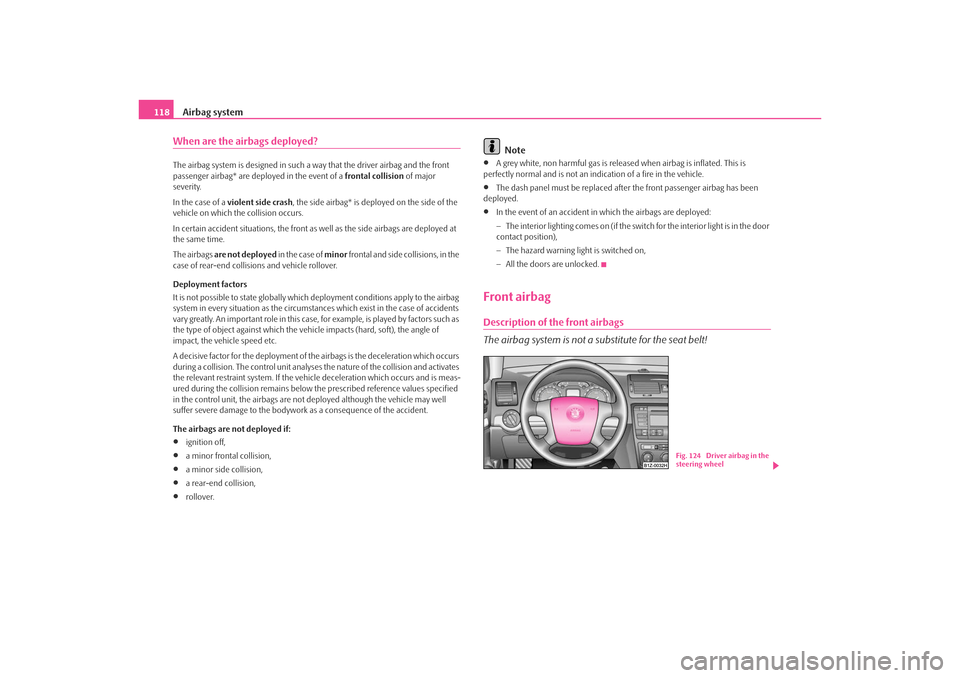
Airbag system
118When are the airbags deployed?The airbag system is designed in such a way that the driver airbag and the front
passenger airbag* are depl oyed in the event of a frontal collision of major
severity.
In the case of a violent side crash , the side airbag* is depl oyed on the side of the
vehicle on which the collision occurs.
In certain accident situations, the front as well as the side airbags are deployed at
the same time.
The airbags are not deployed in the case of minor frontal and side collisions, in the
case of rear-end collisi ons and vehicle rollover.
Deployment factors
It is not possible to state globally which deployment conditions apply to the airbag
system in every situation as the circumstances which exist in the case of accidents
vary greatly. An important role in this case , for example, is played by factors such as
the type of object against which the vehicle impacts (hard, soft), the angle of
impact, the vehicle speed etc.
A decisive factor for the deployment of the airbags is the deceleration which occurs
during a collision. The control unit analyses the nature of the collision and activates
the relevant restraint system. If the vehicle deceleration which occurs and is meas-
ured during the collision remains below the prescribed reference values specified
in the control unit, the airbags are not deployed although the vehicle may well
suffer severe damage to the bodywork as a consequence of the accident.
The airbags are not deployed if:•
ignition off,
•
a minor frontal collision,
•
a minor side collision,
•
a rear-end collision,
•
rollover.
Note
•
A grey white, non harmful gas is released when airbag is inflated. This is
perfectly normal and is not an indi cation of a fire in the vehicle.
•
The dash panel must be replaced afte r the front passenger airbag has been
deployed.
•
In the event of an accident in which the airbags are deployed:
− The interior lighting comes on (if the swit ch for the interior light is in the door
contact position),
− The hazard warning light is switched on,
− All the doors are unlocked.
Front airbagDescription of the front airbags
The airbag system is not a substitute for the seat belt!
Fig. 124 Driver airbag in the
steering wheel
s2ig.book Page 118 Monday, November 10, 2008 11:20 AM
Page 120 of 226
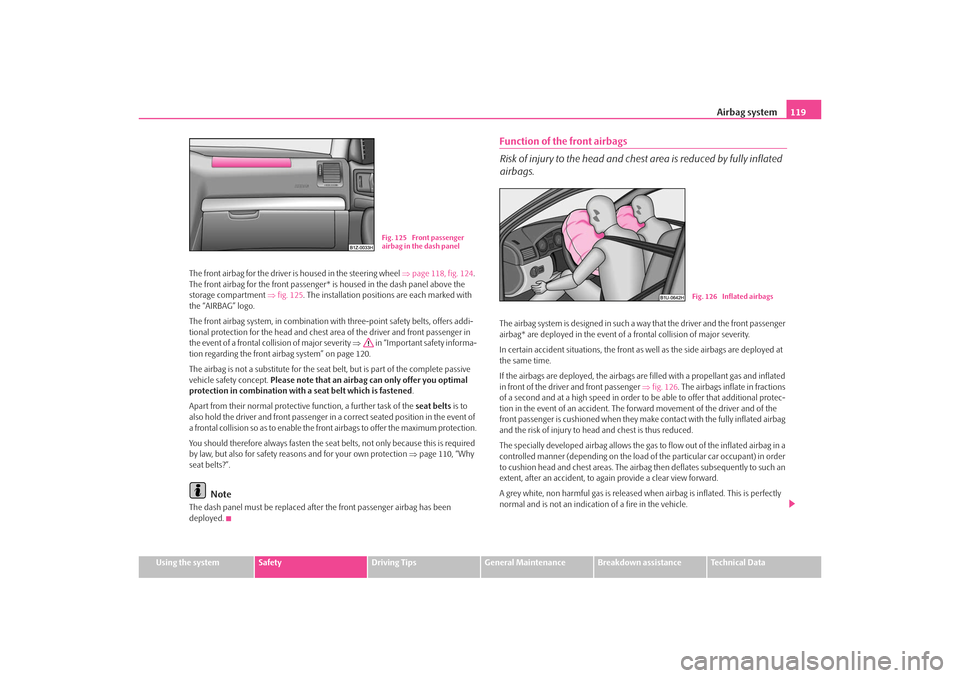
Airbag system119
Using the system
Safety
Driving Tips
General Maintenance
Breakdown assistance
Technical Data
The front airbag for the driver is housed in the steering wheel
⇒page 118, fig. 124 .
The front airbag for the front passenger* is housed in the dash panel above the
storage compartment ⇒fig. 125 . The installation positions are each marked with
the “AIRBAG” logo.
The front airbag system, in combination with three-point safety belts, offers addi-
tional protection for the head and chest ar ea of the driver and front passenger in
the event of a frontal collision of major severity ⇒ in “Important safety informa-
tion regarding the front airbag system” on page 120.
The airbag is not a substitute for the seat belt, but is part of the complete passive
vehicle safety concept. Please note that an airbag can only offer you optimal
protection in combination with a seat belt which is fastened .
Apart from their normal protective function, a further task of the seat belts is to
also hold the driver and front passenger in a correct seated position in the event of
a frontal collision so as to enable the front airbags to offer the maximum protection.
You should therefore always fasten the seat belts, not only because this is required
by law, but also for safety reasons and for your own protection ⇒page 110, “Why
seat belts?”.
Note
The dash panel must be replaced afte r the front passenger airbag has been
deployed.
Function of the front airbags
Risk of injury to the head and chest area is reduced by fully inflated
airbags.The airbag system is designed in such a way that the driver and the front passenger
airbag* are deployed in the event of a frontal collision of major severity.
In certain accident situations, the front as well as the side airbags are deployed at
the same time.
If the airbags are deployed, the airbags are filled with a propellant gas and inflated
in front of the driver and front passenger ⇒fig. 126 . The airbags inflate in fractions
of a second and at a high speed in order to be able to offer that additional protec-
tion in the event of an accident. The forward movement of the driver and of the
front passenger is cushioned when they make contact with the fully inflated airbag
and the risk of injury to head and chest is thus reduced.
The specially developed airbag allows the gas to flow out of the inflated airbag in a
controlled manner (depending on the load of the particular car occupant) in order
to cushion head and chest areas. The airbag then deflates subsequently to such an
extent, after an accident, to again provide a clear view forward.
A grey white, non harmful gas is released when airbag is inflated. This is perfectly
normal and is not an indication of a fire in the vehicle.
Fig. 125 Front passenger
airbag in the dash panel
Fig. 126 Inflated airbags
s2ig.book Page 119 Monday, November 10, 2008 11:20 AM